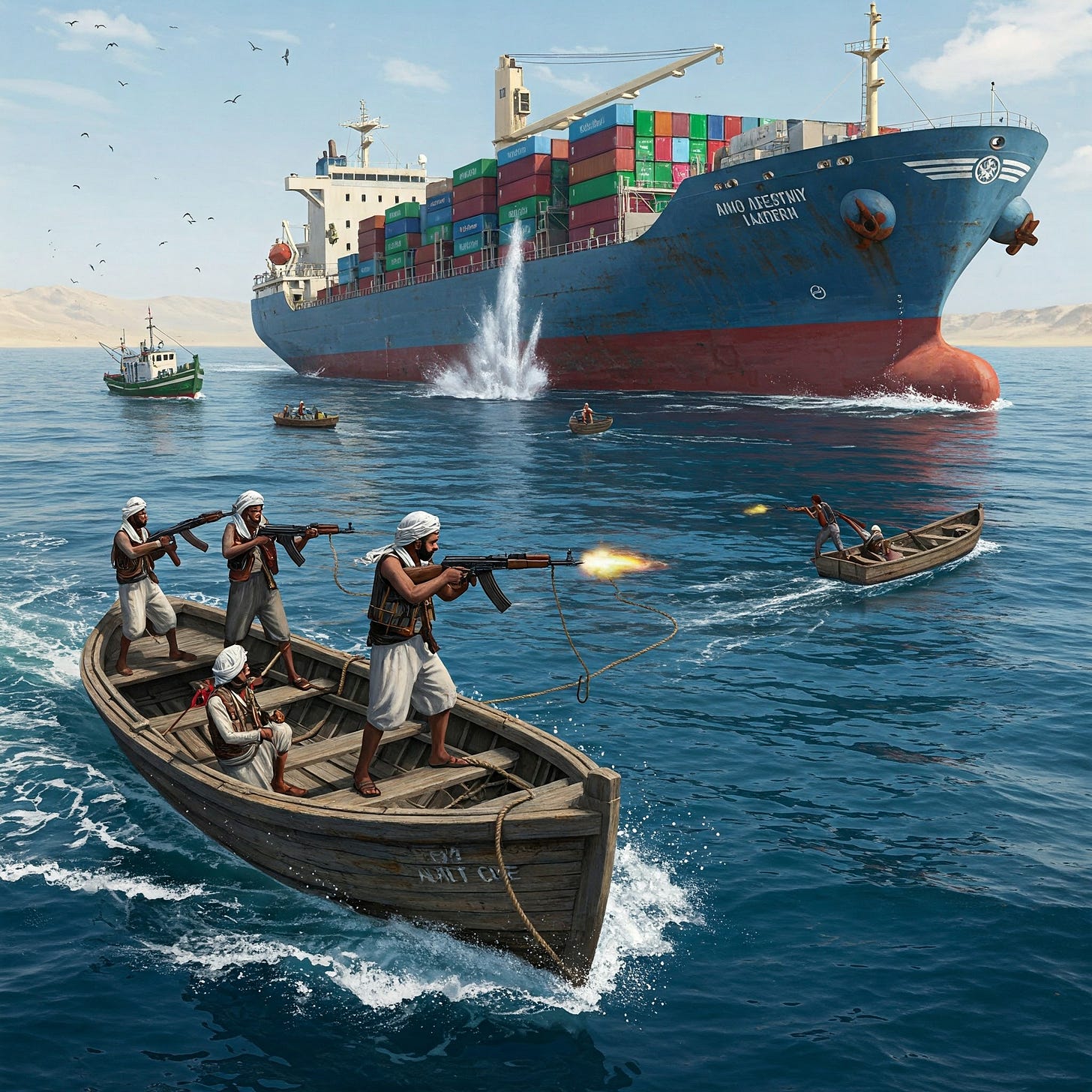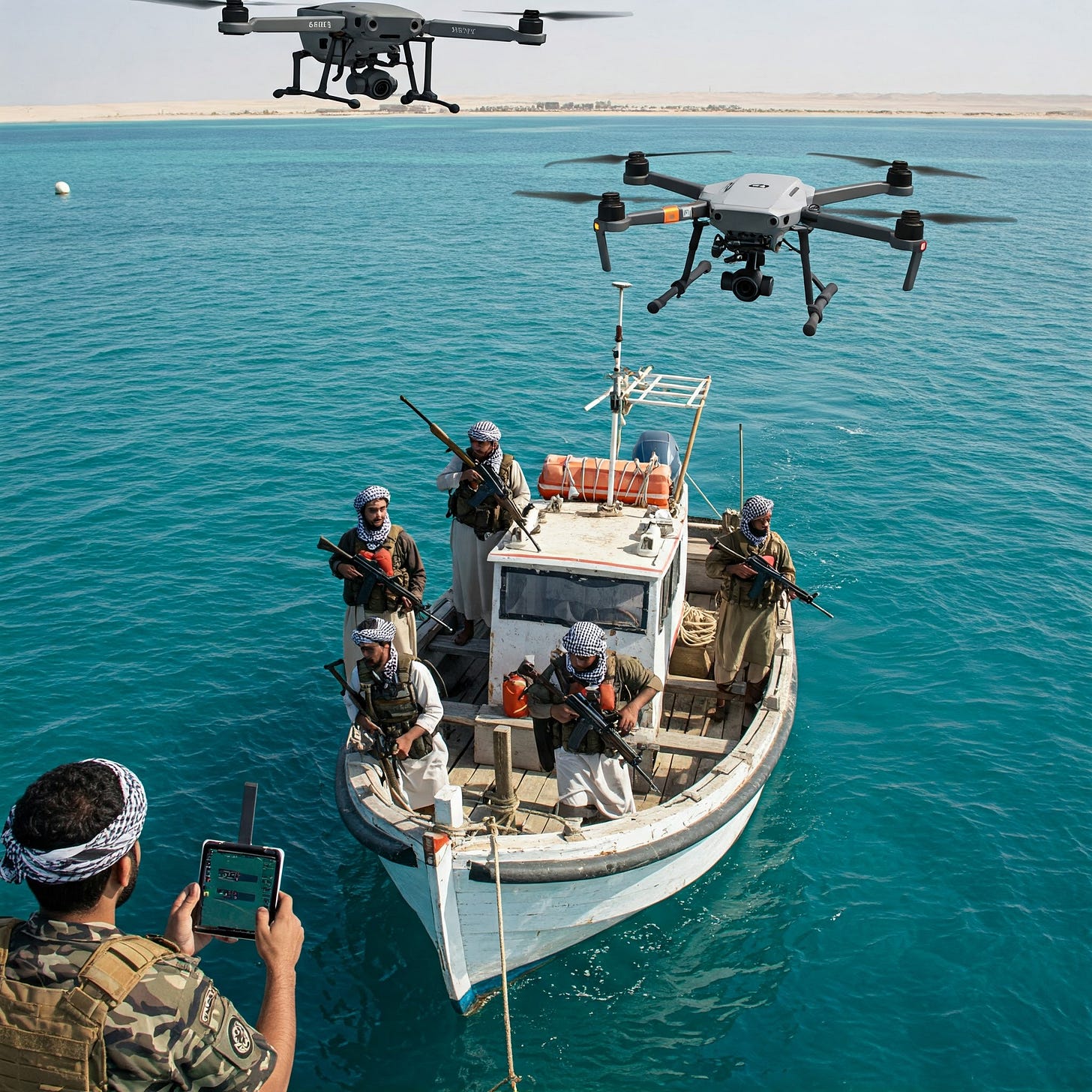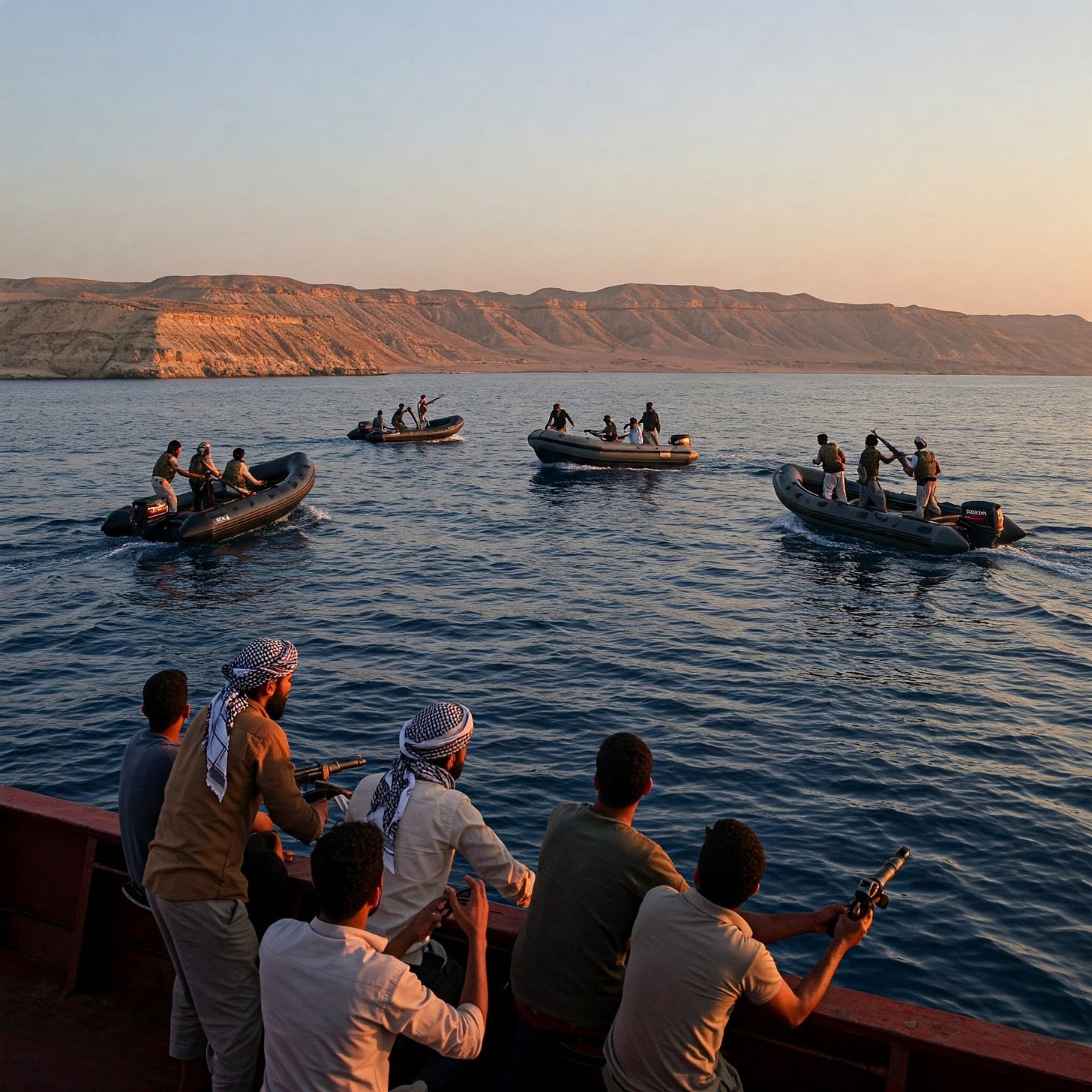Houthi Red Sea Crisis (2025): Asymmetric Warfare, Global Trade & Maritime Shipping Disruption, U.S. Strategic Dilemmas
Can the U.S. neutralize the Houthi rebels & get Red Sea shipping routes back to normal?
Since late 2023, Yemen's Houthi rebels have transformed the Red Sea into a geopolitical flashpoint through persistent attacks on commercial shipping, dramatically escalating global economic instability and directly challenging U.S. strategic interests.
Initially motivated by solidarity with Gaza amidst Israeli military operations, the insurgency has broadened into aggressive hostilities targeting vessels associated with Israel, the United States, and the United Kingdom.
Despite a partial ceasefire declared by the Houthis in January 2025, their aggression has persisted, highlighted by a recent 4-day ultimatum demanding Israel lift its Gaza blockade or face intensified naval strikes.
Since October 2023, over 100 attacks have been recorded, including drone strikes, missile attacks, and ship hijackings, resulting in the sinking of 2 vessels and the deaths of 4 sailors.
These relentless operations have forced ~30% of Red Sea maritime traffic to reroute around Africa's Cape of Good Hope, adding 10-14 days per voyage and significantly raising shipping costs.
Economic Impact
Global Shipping Costs: Increased by an estimated $30 billion annually due to rerouting, heightened insurance premiums, and additional fuel and labor expenses.
Insurance Rates: Surged from 0.05% to between 1% and 2% of vessel value, substantially raising operational expenses.
Annual Financial Toll for the U.S.
Total Estimated Costs: $17-19 billion per year
Military Expenditures (Operation Prosperity Guardian): Approximately $7.8 billion annually
Missile Interceptors: Over $1 billion annually
Indirect Economic Costs: Additional $9–10 billion per year (rerouting impacts, insurance hikes, inflationary pressures)
Strategic Dilemma: The Pentagon faces an unsustainable cost imbalance, spending roughly $2 million per missile to intercept drones costing merely $2,000 each.
Broader global trade impacts exceed $100 billion annually, highlighting the disproportionate economic burden on the U.S. in addressing this asymmetric threat.
2025 Outlook for the U.S.
With Houthi leader Abdul-Malik al-Houthi threatening further escalations, including potential submarine weapon use and operations extending into the Mediterranean, the Red Sea crisis shows no signs of resolution.
This ongoing conflict underscores the complexities and substantial risks associated with safeguarding critical maritime chokepoints against low-cost, high-frequency asymmetric threats.
I. The Houthi Movement
Origins & Ideological Roots
Zaydi Revival: The Houthis trace their roots back to the 1990s “Believing Youth” program in Saada, northern Yemen. Originally, this program aimed to preserve Zaydi Shia identity, which many felt was under threat from the central government and competing religious movements.
Transition to Insurgency (2004): The pivotal point came with the death of founder Hussein Badreddin al-Houthi in 2004, killed by Yemeni government forces. This event galvanized the group to adopt a militant, anti-government stance, merging religious revivalism with a resistance narrative that labeled the state as corrupt and beholden to foreign (particularly U.S./Saudi) interests.
Growing Anti-Western Sentiment: The Houthis’ slogan—often paraphrased as “Death to America, Death to Israel…”—served as a rallying cry, aligning them ideologically with Iran’s “Axis of Resistance.”
Result: This alignment deepened as Iranian proxies (IRGC-Quds Force, Hezbollah) began sharing technical know-how, shaping the Houthis’ shift from small-scale insurgents to regional actors.
Houthi Expansion Timeline
2011–2014
Leveraging Yemen’s political turmoil post-Arab Spring, the Houthis exploited the fractured military and waning central authority.
Built alliances with tribes frustrated by economic hardship; gained partial support from disillusioned military officers.
2015
Rapid territorial gains culminating in the capture of Sana’a, effectively toppling the Yemeni government.
Formally dissolved parliament, establishing governance structures that forced local compliance in northern and coastal Yemen.
Post-2015 to 2023
Consolidation over strategic ports, especially Hodeidah, to tax imports and control aid inflows.
Strengthened maritime capabilities, honing anti-ship missile use and unmanned systems for Red Sea disruptions.
Military Capabilities
Iranian & Hezbollah Support:
Iranian Revolutionary Guard Corps (IRGC) helped supply drones (Shahed series), ballistic/cruise missiles, and advanced communications gear.
Hezbollah contributed expertise in guerrilla tactics, rocket warfare, and C4ISR (Command, Control, Communications, Computers, Intelligence, Surveillance, Reconnaissance).
Arsenal:
Low-Cost Drones: Ranging from $2,000 to $20,000 each, these can swarm or strike with disproportionate psychological and logistical impact.
Anti-Ship Missiles: Land-based launchers capable of hitting large commercial vessels in the Red Sea.
Mobile Launchers & Mines: Deploy sea mines or mount sudden missile launches from hidden coastal areas.
Unmanned Surface Vessels (USVs): Remote-controlled boats designed to blow up near naval or commercial ships, threatening normal maritime traffic.
War Economy:
At least $2B/year from shipping extortion, port taxes, black-market smuggling (fuel, cigarettes), plus forced “tributes” from local businesses.
Provides enough funding to pay fighters, procure new weaponry, and maintain infiltration networks.
Why the Houthis are so Disruptive
Adaptive Inexpensive Tactics: Years of conflict with Saudi-led coalitions taught the Houthis to move launch sites frequently, embed in urban zones, and exploit Yemen’s rugged terrain. Skilled at deploying small, low-cost drones that cost a fraction of the multi-million-dollar interceptors used by U.S./coalition forces.
Strategic Geography: Control over extensive coastline along the Red Sea, particularly near the Bab al-Mandab Strait—a global choke point where ~12% of international trade transits. This grants them leverage: even small-scale attacks cause a ripple effect on insurance rates, shipping lanes, and global freight prices.
Iran Lifeline: Even after airstrikes or special operations degrade Houthi arsenals, Iranian shipments replenish them—drones, missiles, spare parts. Repeated attempts at embargo or sanctions often stall at the UN, with China or Russia preventing a full blockade.
Cost-Asymmetric Warfare: A $2k–$20k drone can cost the U.S. millions in naval resources to intercept or defend against (Aegis systems, advanced anti-air missiles). This ratio drains coalition budgets while the Houthis rely on far cheaper means to produce equivalent strategic disruptions.
Houthis blend insurgent savvy, external backing, and strategic location to punch far above their weight class—leading directly to the Red Sea crisis faced by the U.S. and its allies.
II. The Red Sea Crisis (2023–2025)
Timeline of Escalation
October 2023
First large-scale Houthi missile/drone barrage targeted Israel-linked shipping.
U.S. Navy intercepts missiles aimed at Israeli territory, marking a new era of direct confrontation.
November 2023
Notorious hijacking of the Galaxy Leader cargo ship, signaling the Houthis’ shift to more bold, high-profile maritime aggression.
Shipping insurance spikes, many lines begin rerouting around Africa.
2024–2025
Despite Operation Prosperity Guardian (U.S.-led coalition defensive posture), Houthis maintain ~68% of their pre-campaign missile capacity.
Iranian shipments keep trickling in, while China and Russia diplomatically hamper full-scale blockade attempts.
Shipping Disruption & Cost Impacts
Rerouting Consequences
~42% of vessels that would normally transit Suez-Red Sea now detour via the Cape of Good Hope, adding 10–14 days and roughly $1M in additional operating costs per trip.
Larger container lines pass these costs to global consumers, translating into 8–12% hikes for certain goods (electronics, apparel).
Insurance Premiums Skyrocket
War risk premiums up by 330%, especially for U.S.-flagged and Western-flagged vessels deemed prime targets.
Global Insurers: Lloyd’s of London and other major underwriters classify Red Sea transits as high risk, raising shipping rates further.
Economic Toll on the U.S.
$9.6B/year in added logistics costs, factoring in fuel, insurance, detours, and extended inventory times.
The U.S. Navy itself has spent hundreds of millions intercepting $20k drones with multi-million-dollar intercept missiles, revealing the unsustainable cost asymmetry.
No End in Sight… (2025)
Low-Cost, High-Impact Attacks: Every maritime raid or drone strike, no matter how small, disrupts shipping patterns—amplifying fear in insurers and cargo owners.
Iranian Supply Lines: Frequent weapon smuggling and clandestine cargo shipments to Yemen replenish Houthi stockpiles. China and Russia block or water down comprehensive UN sanctions or naval embargo measures.
Diplomatic Gridlock: Saudi Arabia and the UAE remain cautious, fearing all-out war with Iran if they escalate further. The U.S. cannot easily push a total blockade or permanent naval presence without risking confrontation with two nuclear-armed UN veto holders (China, Russia).
Clash of Interests: In effect, the Houthis leverage their Red Sea position as a chokepoint for extracting geopolitical concessions and revenue, while bigger powers exploit the stalemate to keep U.S. resources tied down—resulting in a protracted crisis with no obvious exit under the current defensive approaches.
III. U.S. Navy Efforts to Date & Limitations
A.) Operation Prosperity Guardian (Late 2023–2024)
Operation Prosperity Guardian failed to stop Houthi attacks despite being the U.S. Navy’s longest-sustained naval battle since WWII.
Resulted in a prolonged conflict with no clear resolution — and was described as a “resounding failure” that exposed strategic weaknesses in U.S. Middle East policy.
Led to calls for complete policy overhaul from military leaders like General Kurilla — who advocated transitioning to proactive/offensive ops.
Allowed Houthis to set dangerous precedents for maritime blockade tactics.
Coalition Scope & Goals
In December 2023, the United States launched Operation Prosperity Guardian alongside the UK and several regional partners.
Objective: Protect commercial shipping through the Red Sea and achieve near-100% interception of Houthi-launched missiles, drones, or unmanned surface vessels.
Defensive Posture
Naval Assets: Multiple U.S. destroyers, frigates from European allies, and surveillance drones patrolled critical corridors.
Rules of Engagement: Largely reactive—focus on intercepting incoming threats, rather than neutralizing Houthi launch sites deep in Yemeni territory.
Success Rate: Around 61% in preventing actual hits on commercial vessels, leaving a gap (≈39%) where either intercepts failed or some attacks slipped through.
Pitfalls
Cost Asymmetry: Houthi drones/missiles cost a tiny fraction of the multi-million-dollar interceptors (e.g., SM-2 or SM-6). Even if some are shot down, the expense to the U.S. and partners is disproportionately high.
No Revenue Disruption: The Houthis continued extorting fees, controlling ports, and receiving Iranian supplies. Guardian’s purely defensive nature did not choke off funds or hardware inflows.
Maintenance/Operational Strain: Keeping a robust naval presence for a high-intensity intercept mission led to rapid wear on ships and systems, risking readiness in other theaters (e.g., Indo-Pacific, Black Sea).
B.) Targeted Air & Missile Strikes
Precision Strikes on Houthi Infrastructure
The U.S. intermittently launched targeted air or cruise missile attacks on known Houthi radar sites, drone factories, and missile storage depots.
Extent: Roughly 127+ strikes documented between early 2024 and mid-2025.
Partial Impact: Destroyed immediate threats (like coastal radar or rocket caches), but results often short-lived due to quick relocations and rebuilt stockpiles.
Iranian Resupply Pipeline
Crucial Limitation: Even after a successful strike, Iranian shipments (smuggled via the Gulf of Aden, Omani or Somali routes) replenished Houthi losses within weeks.
Houthi forces, aided by Iranian/Hezbollah advisors, learned to disguise or conceal key facilities, minimizing the effect of repeated aerial attacks.
Tactical Wins, Strategic Stalemate
While individual strikes prevented certain large-scale attacks (e.g., rumored ballistic strikes on Saudi or Israeli targets), the overall campaign did not erode the Houthis’ fundamental ability to sustain maritime disruptions.
C.) Diplomatic & Sanctions Approach
Houthi Leaders on Sanctions Lists
Multiple Houthi figures (military and political leaders) faced U.S. and UN sanctions, freezing overseas assets and restricting travel.
Reality: Houthis relied on local/regional networks and secret smuggling channels, making formal sanctions less damaging.
China/Russia’s Blocking Role
At the UN Security Council, attempts to authorize a stricter blockade or universal arms embargo often failed due to vetoes or abstentions by China and Russia.
Both nations argued for negotiations or cited “humanitarian concerns,” effectively weakening concerted global pressure.
Crypto/Gold & Smuggling Loopholes
Even with standard financial sanctions, the Houthis utilized cryptocurrency (especially via local or regional exchangers) and gold-based transactions to bypass typical banking channels.
This undercut the ability of Western-led sanctions to fully sever their funding streams.
D.) Core Cost Asymmetry & Iranian Lifeline
The Cost Imbalance
Each $20k Houthi drone can force the U.S. to deploy a $2M interceptor or advanced electronic warfare (EW) measures.
U.S. budgets (already ~$800B in defense) still face a major burn rate when dozens of drones/missiles can be launched over weeks or months.
Iranian Continuous Support
IRGC shipments replenish ~68% of lost Houthi missile/drone capacity after each round of strikes.
Covert maritime routes, nominally flagged freighters, and smaller fishing vessels all serve as potential conduits.
Why the U.S. Is “Stuck”
A purely defensive approach allows Houthis to bleed the U.S. with relatively cheap attacks.
Diplomatic efforts to cut off Iranian arms or unify the UN behind a full embargo repeatedly falter, leaving the Houthis operationally functional and financially afloat.
IV. Key Players: China, Russia, Iran, Saudi Arabia, UAE - Navigating Houthis & the Red Sea
A.) China: Strategic Opportunism
Strategic Balancing & Economic Aims
Dual-Use Tech Transfers: Through front companies (e.g., Shenzhen Rion Technology, Shenzhen Jinghon Electronics), China covertly supplies components—such as missile-guidance circuits and drone parts—to Houthi forces in exchange for unimpeded passage of Chinese-flagged vessels in the Red Sea.
BRI Priorities: Investments in ports like Djibouti, Gwadar, and potential Red Sea expansions underscore Beijing’s goal of reliable shipping routes. Yet, limited “controlled instability” keeps the U.S. preoccupied, reducing American pressure on other Chinese interests.
Diplomatic Ambiguity
UN Abstentions: China consistently abstains from resolutions condemning Houthi attacks, preserving neutral ties with Iran and Gulf states. This stance also prevents a major international blockade that might escalate shipping disruptions, which could threaten Belt and Road routes.
Immunity for Chinese Ships: Maritime data indicates Houthi forces seldom target vessels linked to Chinese firms, suggesting behind-the-scenes deals guaranteeing “safe passage.”
Constraints & Calculations
China avoids a direct clash with the U.S. over Yemeni waters, fearing harm to its trade volumes and global financial standing.
Balances its desire for stable BRI maritime routes with letting the U.S. remain partially distracted in the region.
B.) Russia: Geopolitical Disruption & Hybrid Warfare
Disruption Tactics & Arms Supply
Targeting Data & Potential Arms Deals: Russian intermediaries share satellite intelligence with Houthis. Alleged discussions on advanced anti-ship missiles (Yakhont or similar) stirred alarm in Washington and Riyadh.
UNSC Veto: Leveraging its Security Council seat, Russia waters down or blocks proposed sanctions that might throttle Houthi arms inflows.
Economic Constraints
Oil Revenue Dependence: Moscow is vulnerable if a prolonged crisis causes significant oil price drops, diminishing its export earnings. It thus carefully calibrates arms support so as not to trigger a heavy Saudi/U.S. oil “flood” or broader sanctions that would harm Russia’s finances.
Ties to Gulf States: Maintains profitable relationships with Saudi Arabia and the UAE; avoids measures that directly threaten Gulf shipping lanes, preferring to keep conflict at a simmer rather than a boil.
Motivations & Limits
Spoiler Role: Gains from U.S. entanglement, arms sale opportunities, and showcasing advanced military tech.
Limit to Escalation: Overly robust Houthi support could provoke massive retaliation against Iranian or Russian assets and drive down oil prices—outcomes Russia prefers to avoid.
C.) Iran: The Primary Houthi Sponsor
Core Enabler & Proxy Warfare
IRGC-Quds Force: Provides drones, missiles, and trainers, enabling high-impact Houthi maritime attacks (85% of Houthi strike capability in 2024 traced to Iranian hardware).
Axis of Resistance: Views the Houthis as a key proxy applying pressure on Saudi Arabia, aligning with Iran’s broader mission of countering Western/Gulf alliances.
Economic & Political Calculations
Sanctions-Weakened Economy: Tehran cannot afford an all-out confrontation if the U.S. threatens to cut off its oil exports or impose harsher penalties. Fluctuations in oil prices directly affect government stability.
Nuclear Bargaining Chip: Houthi attacks can divert U.S. attention from Iran’s nuclear dossier, offering Iran leverage in negotiations with Western powers.
Calibrated Support
While eager to maintain the Houthis as a regional thorn for Saudi Arabia, Iran moderates arms transfers to avoid provoking a unified crackdown on its own shipping routes (especially the Strait of Hormuz).
D.) Saudi Arabia & UAE: Defensive Postures & Regional Risks
Defensive & Economic Pressures
Security Vulnerabilities: Frequent missile/drone threats to Saudi infrastructure; the UAE’s DP World operations see reduced traffic due to Red Sea disruptions.
Relying on U.S.: Prefer robust American intelligence, airstrikes, and naval interception to degrade Houthi capacities. Hesitant about a large-scale ground invasion unless the Houthis are significantly weakened first.
Diplomatic Balancing
Ceasefire Attempts: Saudi-led initiatives push for negotiations, but Iranian backing sustains Houthi intransigence.
Investment Risks: UAE’s East African and Red Sea infrastructure expansions remain vulnerable if the conflict persists.
Potential for Ground Engagement
Saudi/UAE forces can capture strategic ports (e.g., Hodeidah) once Houthis are in disarray. The U.S. typically supports from the air/intelligence side, reducing the Gulf states’ chances of becoming stuck in a prolonged quagmire.
E.) United States
Coalition Challenges & Advanced Threats
Operation Prosperity Guardian has prevented some attacks but not eliminated Houthi high-end weapons, many supplied by Iran and possibly enabled by Chinese or Russian components.
UN Blockade Hurdles: Russian/Chinese veto power disrupts attempts at a full arms embargo or strict maritime blockade.
Escalatory Gaps
Cost Asymmetry: $2k–$20k Houthi drones require multi-million-dollar U.S. interceptors. The U.S. invests billions annually in Red Sea patrols and missile defense.
Recent Tensions: Renewed Houthi threats in March 2025 (linked to Gaza aid demands) highlight the group’s persistent ability to upset shipping lanes, even after extensive U.S. strikes.
Goal & Constraints
Seeks a rapid end to the crisis to reduce military overhead, secure trade routes, and avoid indefinite engagements.
Must reconcile Gulf ally needs (Saudi, UAE) with diplomatic realities shaped by China’s and Russia’s partial shielding of the Houthis at the UN.
Overall Dynamics
The interplay among these actors underpins the 2025 Red Sea crisis:
China enables Houthi arms supply indirectly while preserving safe passage for Chinese shipping; benefits if the U.S. is stretched thin.
Russia uses the conflict as a geopolitical lever, balancing arms sales/veto power with oil price concerns and relationships with Gulf states.
Iran sustains the Houthis as a low-cost proxy front against Saudi Arabia and the U.S., though it faces constraints from its fragile economy and potential blockades.
Saudi Arabia & UAE endure economic fallout and ongoing security threats, relying on external (mainly U.S.) military capabilities to contain Houthi advances.
The United States leads defensive coalitions but struggles to overcome the cost asymmetry, external vetoes, and covert supply chains that keep Houthi capabilities replenished.
V. How the Houthis Operate (2025)
A.) Adaptive Tactics
Lessons Learned from Saudi Airstrikes
Over nearly a decade of sporadic conflict, the Houthis developed mobile launcher concepts, hiding missile systems in mountainous terrain or urban locales.
Rapid relocation reduces the effectiveness of conventional air campaigns aimed at fixed targets.
Hybrid Warfare
Combine guerrilla methods (IEDs, raids) with advanced drone and missile technology from external allies.
Maintains a “low profile, high impact” approach, forcing adversaries to expend disproportionate resources.
B.) Technological Leverage
Iranian Expertise
IRGC engineers provided know-how for ballistic missile assembly, GPS guidance upgrades, and drone swarm tactics.
Hezbollah trainers taught infiltration, “shoot-and-scoot” artillery methods, and secure communications.
Drones & Unmanned Surface Vessels (USVs)
Cheap, expendable drones with significant strike capacity hamper multi-billion-dollar navies.
USVs threaten shipping from below radar coverage, again at a fraction of typical Western naval costs.
C.) Revenue Streams
“Protection Fees” & Port Taxes
Houthis impose “fees” on shipping lines to avoid or reduce attacks, generating up to $2B/year.
Control over ports like Hodeidah also yields customs/tax revenues on vital imports.
Smuggling & Contraband
Fuel, tobacco, and weapon smuggling networks route profits back to Houthi administrators.
In some areas, the Houthis forcibly confiscate property or levy heavy taxes, building a war chest that sustains recruitment and arms acquisitions.
Crypto/Gold Laundering
Relying on cryptocurrency or gold bars to circumvent formal financial channels.
This resilience complicates U.S.-led sanctions, as normal banking blacklists fail to cut off all money flows.
D.) Strategic Geography
The Bab al-Mandab Strait
A choke point connecting the Red Sea to the Gulf of Aden, through which a significant share (up to 12%) of global maritime trade passes—particularly oil shipping.
Houthis exploit this maritime geography to threaten or attack passing vessels, leveraging global supply chain sensitivities.
Logistical Advantages
Yemen’s rugged coastline and limited government authority in many regions let Houthi smuggling routes flourish.
Attempts to patrol or blockade the entire Red Sea coastline are expensive and logistically demanding for external forces.
Psychological & Economic Leverage
By occasionally striking or threatening large tankers and cargo ships, the Houthis magnify global insurer fears, driving up shipping costs.
Even minor attacks have outsize effect, proving the Houthis’ ability to coerce, extort, or disrupt at will.
VI. Strategy for the U.S. vs. Houthis in the Red Sea
Ideally we want to: (A) cost/time-efficiently restore safe U.S. maritime passage through the Red Sea without disruption AND (B) lock-in a permanent maritime security advantage to prevent another scenario like this in the future — without requiring indefinite military presence or ending up in a long-term money pit or world war.
Strategic Objectives:
Rapid Neutralization: Eliminate the Houthi threat within 90–120 days to restore free passage.
Long-Term Security: Maintain a low-cost, autonomous, and sustainable maritime security system.
Permanent Deterrence: Create irreversible cost asymmetries that discourage any future Houthi resurgence or external support from Iran, China, and Russia.
Minimal U.S. Footprint: Transition from large-scale forces to a covert, technology-driven posture once objectives are met.
Phase 1: Decisive Disruption & Leadership Decapitation (Days 1–30)
Precision Houthi Leadership Elimination
Action: Deploy stealth drones (MQ-9 Reapers, RQ-180) and Special Operations units for simultaneous raids on high-value Houthi targets.
Targets: Key Houthi commanders (drone and missile specialists), along with embedded Iranian IRGC and Hezbollah liaisons.
Method: Execute overlapping strikes and raids to prevent any regrouping; concurrently release disinformation attributing the losses to internal betrayals.
Expected Outcome: Rapid command vacuum and disorganization within Houthi ranks, significantly reducing coordinated maritime operations.
Sabotage of Maritime Assets and Supply Lines
Action: Employ unmanned underwater vehicles (UUVs) and limpet mines to sink unflagged Iranian arms-smuggling vessels near Yemeni coasts.
Additional Step: Launch cyber operations to disable Houthi port radars, missile/drone production lines, and communications networks.
Outcome: Immediate halt to ongoing Red Sea attacks and a crippling reduction in the Houthis’ ability to launch further operations for at least 30 days.
Financial Chokehold
Action: Freeze or seize Houthi-linked cryptocurrency wallets through a coordinated NSA/Treasury operation.
Method: Infiltrate and disrupt major smuggling routes via local operatives to force Iranian resupply into riskier, less efficient channels.
Outcome: Severely limit the Houthis’ funding, undermining recruitment, logistics, and bribery capabilities.
Phase 2: Containing External Support (Days 1–60)
Iran: Economic & Logistical Strangulation
Action: Conduct covert sabotage (via cyberattacks and precision explosives) at critical Iranian oil terminals (e.g., Kharg Island, Bandar Abbas).
Method: Deploy additional submarine drones to intercept Iranian arms shipments in the Gulf of Aden and Arabian Sea under plausible deniability.
Goal: Inflict significant economic and operational costs on Iran, forcing it to scale back its support for the Houthis.
China: Balanced Incentives & Covert Threats
Carrot: Quietly offer Chinese firms lucrative, post-conflict infrastructure contracts in Yemeni ports under U.S. security guarantees.
Stick: Threaten targeted sanctions—such as blacklisting major Chinese shipping companies (e.g., COSCO) and restricting advanced technology exports—if China is found directly supporting Houthi resupply networks.
Outcome: Encourage Beijing to opt for neutrality, as the economic cost of active involvement would outweigh any benefits.
Russia: Disruption of Arms Routes & Economic Pressure
Action: Utilize local proxies (in Sudan/Eritrea) to sabotage Russian arms shipments intended for the Houthis.
Additional Measure: Coordinate with Saudi Arabia and UAE to execute an “oil flood” strategy, driving global prices down and further straining Russia’s fragile economy.
Outcome: Make continued Russian support for the Houthis economically and strategically unsustainable.
Phase 3: Long-Term Maritime Security & Local Stabilization (Days 30–120+)
AI-Driven Maritime Drone Network
Action: Deploy hundreds of cost-effective, autonomous unmanned surface and underwater drones (e.g., MARTAC T38, Orca UUVs) across the Bab al-Mandab and key Red Sea chokepoints.
Capability: Integrate real-time AI analytics with CENTCOM’s intelligence to automatically detect, intercept, and neutralize any suspicious or hostile vessels.
Outcome: Establish a persistent, low-cost maritime security net that replaces the need for expensive carrier groups.
Regional Port Diversification
Action: Invest in and accelerate the expansion of Berbera Port in Somaliland with UAE co-funding.
Result: Reroute 25–35% of Red Sea trade away from vulnerable Yemeni ports, reducing the Houthis’ leverage over global shipping lanes.
Limited Ground Stabilization & Local Engagement
Action: Support a targeted, Saudi/UAE-led ground operation to secure strategic coastal cities (e.g., Hodeidah) post-decapitation.
Method: Provide minimal U.S. intelligence and drone air support while incentivizing local tribes with basic infrastructure and economic benefits.
Outcome: Local populations become aligned with stable, commercially oriented governance rather than insurgency, ensuring the long-term collapse of Houthi influence.
Risk Mitigation: Credible, Covert Deterrence & If/Then Scenarios
Ambiguous Mission Framing: Publicly present all actions as standard “maritime security” and anti-piracy operations, while privately retaining plans for rapid, covert escalation if any adversary intervenes.
If/Then Scenarios:
If Iran escalates arms flows: Launch additional covert sinkings of Iranian vessels and expand cyber sabotage against additional oil terminals, forcing Iran into a costly, unsustainable position.
If China deploys warships or supports arms shipments: Initiate targeted sanctions and employ covert GPS spoofing to disrupt Chinese cargo flows; threaten additional economic penalties.
If Russia increases arms transfers: Coordinate with Gulf allies for an oil flood to drive prices below critical thresholds and sabotage key arms shipments via local proxies.
If Houthis resume significant attacks: Conduct immediate lethal strikes on any reconstituted port or production facilities using autonomous drones, ensuring any resurgence is quickly neutralized.
End-State (90–120 Days)
Houthi Capability Neutralized: Leadership decapitated, supply lines severed, and financial networks crippled. Residual elements are too disorganized and underfunded to mount sustained attacks.
Permanent Maritime Security: The autonomous drone network and diversified port infrastructure ensure uninterrupted shipping lanes with minimal ongoing U.S. cost.
Sustainable Deterrence: Adversaries (Iran, China, Russia) are deterred by the demonstrated cost of interference—any escalation invites a swift and disproportionate covert response.
Minimal U.S. Footprint: After 120 days, large-scale forces withdraw, leaving behind a small, agile surveillance and infiltration team supported by autonomous systems and robust regional partnerships.
How will Trump likely deal with the Houthi Red Sea scenario?
Based on public statements, historical actions, and analysis of Trump’s “America First” approach, the U.S. under Trump is likely to pursue a hardline strategy in the Red Sea.
On January 22, 2025, U.S. President Donald Trump re-designated the Houthis as a foreign terrorist organization:
Within one month of taking office, the Biden administration reversed the Houthis’ designation.
As a result of the Biden administration’s weak policy, the Houthis have fired at U.S. Navy warships dozens of times, launched numerous attacks on civilian infrastructure in partner nations, and attacked commercial vessels transiting Bab al-Mandeb more than 100 times.
The Executive Order directs the Secretary of State, in consultation with others, to recommend the re-designation of the Houthis within 30 days.
Under President Trump, it is now the policy of the United States to cooperate with its regional partners to eliminate the Houthis’ capabilities and operations, deprive them of resources, and thereby end their attacks on U.S. personnel and civilians, U.S. partners, and maritime shipping in the Red Sea.
Following the Houthis’ re-designation as an FTO, the Executive Order also directs the Administrator of the United States Agency for International Development (USAID) and the Secretary of State to jointly review United Nations partners, nongovernmental organizations, and contractors operating in Yemen.
Following this review, the President will direct USAID to end its relationship with entities that have made payments to the Houthis, or which have opposed international efforts to counter the Houthis while turning a blind eye towards the Houthis’ terrorism and abuses.
Trump is likely to green-light “whatever it takes” to fix this situation. The problem is that the Houthis are extremely adaptive and difficult to eradicate cost-effectively. You don’t want to end up spending far more money than you are already for a never-ending game of Houthi “whack-a-mole” in the Red Sea.
You also don’t want to get caught up in some middle east conflict escalation that requires far more resources than present. There are many strategic maneuvers the U.S. can make to fix the Red Sea dilemma.
What was Biden's strategy?
Biden's approach combined limited military action, sanctions, and diplomatic efforts, aiming to weaken the Houthis without triggering a broader escalation:
Military Action: Airstrikes and naval operations to deter Houthi attacks on commercial shipping, but these were restrained to avoid a full-scale conflict.
Diplomacy: In 2021, Biden removed the Houthis from the Foreign Terrorist Organization (FTO) list to ease humanitarian aid delivery and foster peace negotiations. However, this did not halt Houthi aggression.
Sanctions: Later, he designated the Houthis as a "Specially Designated Global Terrorist" (SDGT) group—a less severe label than FTO—balancing pressure with humanitarian considerations.
Outcome: Critics argue this cautious strategy failed to stop Houthi attacks, as the group continued targeting ships despite the limited military response and diplomatic outreach.
Trump's most likely strategy (2025)
Trump will pursue a more aggressive, military-focused strategy, emphasizing deterrence through strength.
Military Action: Expanded airstrikes and supported special forces operations to directly degrade Houthi capabilities. Aims to disrupt the group’s operations more decisively.
Designations: Reinstated FTO label, signaling a hardline stance. This move aims to cut off Houthi resources and isolate them internationally.
Regional Support: Bolstered efforts to interrupt Houthi weapons supply lines, particularly from Iran. Backed allies like Saudi Arabia in countering.
Aim: Trump’s strategy aims for quicker resolution through overwhelming force, though it risks escalating tensions and further destabilization.
This Red Sea dilemma is costing the U.S. et al. a lot of money each year (directly & indirectly)… it may worsen before it gets better. Clearly a new geopolitical strategy was needed — as Biden made zero headway.










